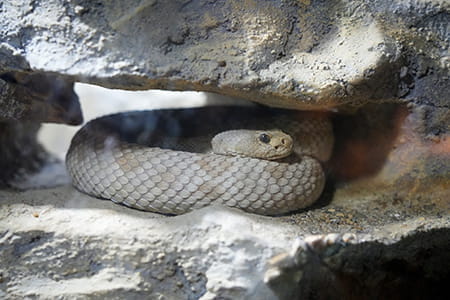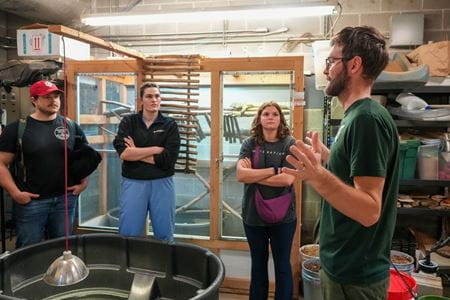On a pristine spring day in late March, a group of adventurous medical students ventured outside the classroom to spend an afternoon surrounded by creatures that creep, crawl and slither.
Members of the Wilderness Medicine Student Interest Group, offered through the IU School of Medicine, didn't have to travel to a foreign land for a crash course in venomous spiders and serpents. They simply ventured a few miles down the road to visit the medical school's downtown neighbor, the Indianapolis Zoo.
Curator Lewis Single took the 15 curious students behind the scenes at the zoo's desert exhibit, where venomous snakes and spiders are kept. He led a demonstration on how to safely transport the animals, and he explained the properties of the polyvalent antivenoms kept on hand in zoos across the country in case of any exceedingly rare accidents.
"There are some snakes native to northern and southern Indiana," he explained, "but spider bites are more common in the Indianapolis area."
Catherine Milne, a second-year medical student, was surprised to learn the zoo only needed to keep two types of broad-spectrum antivenom on hand: One for North American snake varieties, another for African types.

A venomous Catalina Island Rattlesnake rests in its enclosure at the Indianapolis Zoo. | Photo by Tim Yates, IU School of Medicine
"That makes it much easier for providers to render care," she said.
Milne joined the Wilderness Medicine group to meet people and "get away from a desk." She and her classmates typically go on some sort of outdoorsy excursion about once a month. Other topics range from performing water rescues to setting bones during hiking accidents.
"Hopefully, I will never need to use my snake knowledge," Milne said.
Grace Charpentier, also a second-year medical student, is the group's research event coordinator.
"I’m interested in working in a global health environment with less resources," Charpentier said of her reasoning for joining the club.
She said the Wilderness Medicine group’s events teach paramedic-like skills that can supplement traditional medical education, while also bringing students together for some fun activities.
"Our goal is to teach practical medical skills at an earlier stage in the education," said Matthew Durthaler, the group's vice-president and a third-year medical student.
Many of the students have an interest in primary care or emergency medicine in rural or even remote settings, he added. Non-medical skills are also taught, such as how to organize a search-and-rescue party.
The club will soon meet with a toxicology expert to learn the second half of this day's lesson: What to do with a patient who has been bitten by a venomous animal.
For Durthaler, the group also serves as a motivator during the school's rigorous coursework.
"This is a way to get students excited about medicine while still in the classroom-heavy part of our education."
